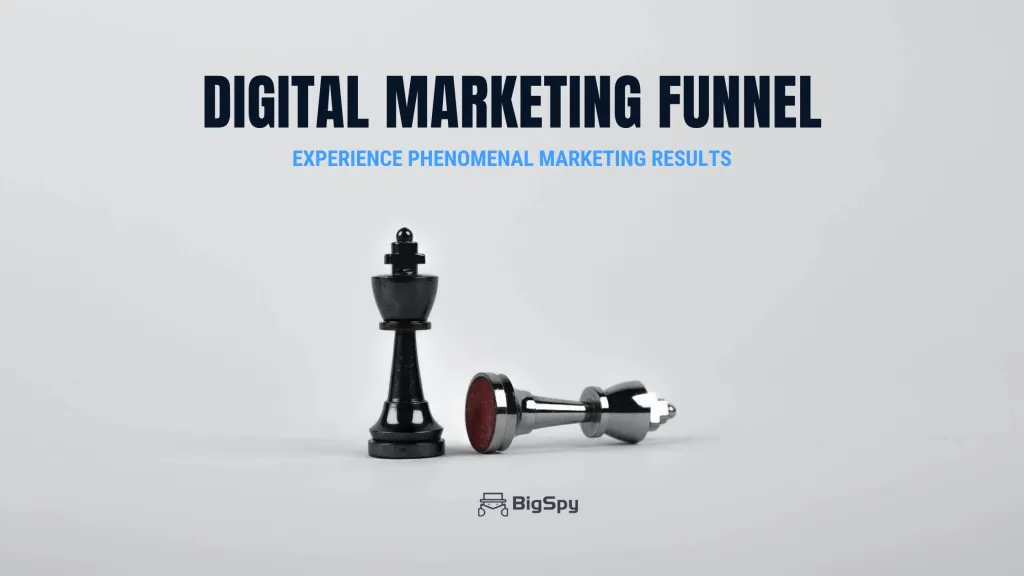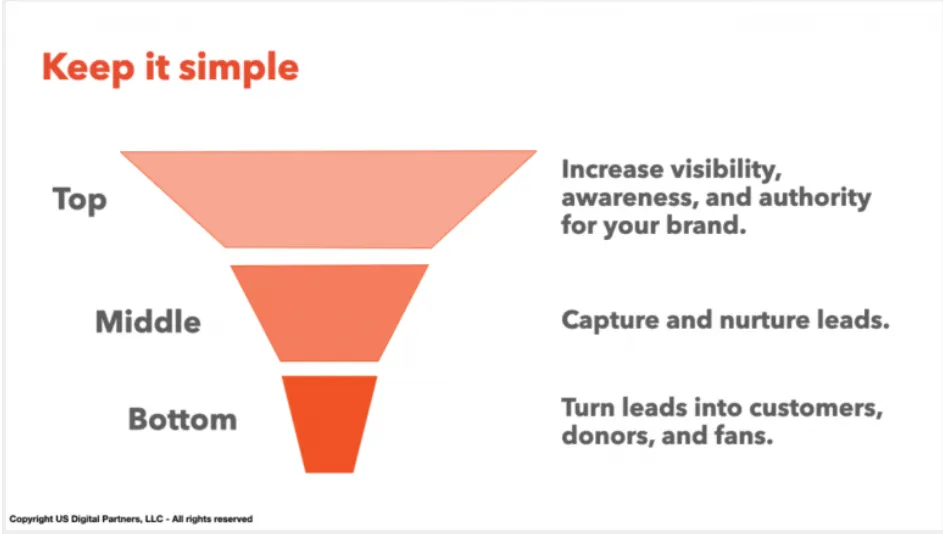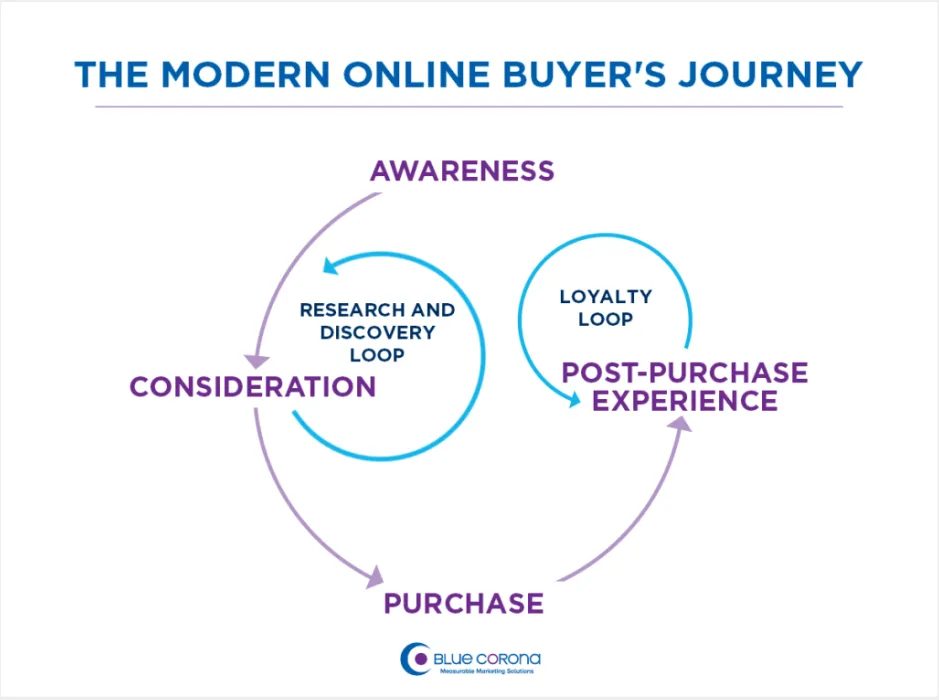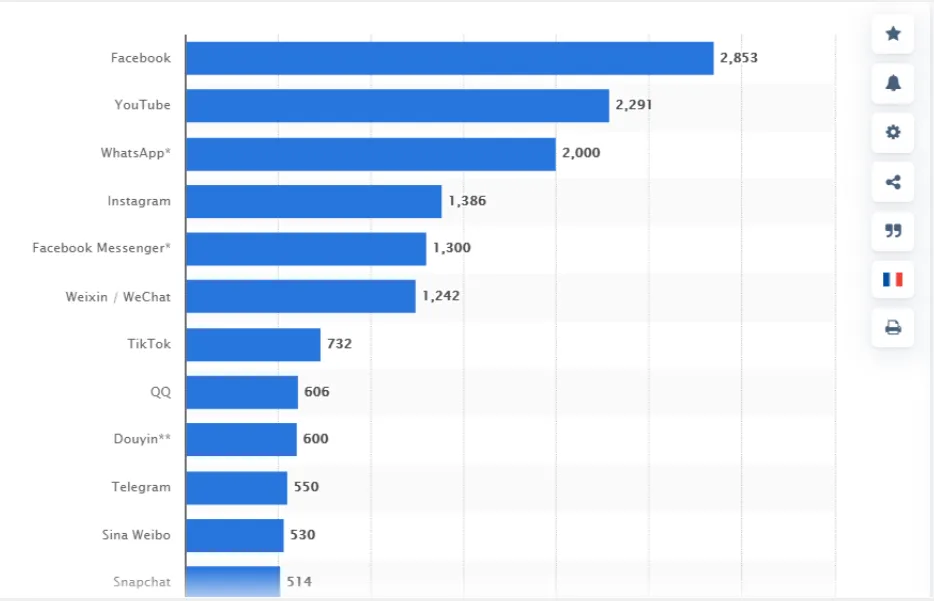How To Optimize Every Stage of Your Digital Marketing Funnel

A marketing funnel is a process of guiding leads through a journey that transforms them into paying customers.
Digital marketing and sales funnels follow a similar route where there are different stages along the way to an ultimate goal, which may be monetary or nonmonetary, such as making a sale, getting a sign-up for a free trial, collecting a person's email address, etc.
This article takes a look at the different ways you can use to optimize every stage of your digital marketing funnel, including the top, middle, and bottom of the funnel.
So read on to discover some of the most powerful strategies for improving each stage of the funnel so you can experience phenomenal marketing results.
But first, let’s take a closer look at the modern marketing funnel.
Understanding the Modern Marketing Funnel
Marketing funnels are sometimes referred to as "customer journeys" and consist of different stages that represent the corresponding state of mind of the potential customer.
The standard top-down formula for marketing funnels is as follows:
- It starts at the top with the awareness and interest phase.
- The middle has the consideration and preference stage.
- And way down at the bottom we have the purchase stage.
There is also a post-purchase experience that focuses on support, loyalty, and advocacy.
In order to successfully move people from one end of the funnel to the other, it's essential to optimize each stage so you can give your visitors exactly what they want at just the right time to compel them to move forward in the funnel toward becoming a paying customer.
It's also important to understand that while similar to the traditional marketing funnel, the modern funnel isn't a linear journey, but rather a looping one that is filled with twists and turns, as shown in the image below:
For example, someone looking to remodel their bathroom (let's call her Sandra) might decide to go on Pinterest or Instagram for ideas on great designs for modern bathrooms.
This is the "awareness" stage.
Later on, after saving all her favorite ideas, Sandra then starts searching on Google for a good local remodeler.
This is the "consideration" stage.
After a while, Sandra goes on Facebook to ask her friends for bathroom designer recommendations.
She is back at the awareness stage.
After her friends give her a list of recommendations, Sandra checks out each of the companies’ reviews online.
This is the consideration stage again.
After making her choice of the best bathroom remodeler, she goes to the company's website and books a consultation appointment (Purchase Stage).
As you can see, her journey from awareness to consideration to purchasing isn't linear. The same goes for the “loyalty” loop and customers can go around and around before moving to the next phase.
Here are a few instances of what a loyalty loop might look like for the example above:
- Sandra raves on Facebook about the new bathroom and how professional the bathroom remodeling company was - Loyalty Loop.
- She documents her entire bathroom remodeling experience on her Instagram profile - Loyalty Loop.
- After being prompted via email, she leaves a review on a third-party review website - Loyalty Loop.
- After a few months, part of Karen's roof caves in, and rather than go through the awareness and consideration phases again, she calls the remodeler directly to get a quote - Loyalty Loop (leading to purchase).
When designing the marketing funnel, it is important to carefully evaluate all costs, sources of revenue, and profitability of all channels within the funnel. Reducing variable expenses while ensuring proper channel management is an absolute must if you’re going to create a marketing funnel that converts.
Thalita Ferraz, owner of HerBones.com, a popular beauty and fashion website explains, “I’ve found from my own ecommerce brand that it usually takes on average three different positive experience post-purchase in order to really hook a customer in. Now we have a process to make sure we focus on making the customer smile three times AFTER purchasing our products, and that has led to a 34% increase in repeated buyers.”
Top of the Funnel (ToFu)
Now that you understand the structure of a modern digital marketing funnel, you can create a framework that will be more effective for improving your conversions, starting at the top.
Here are some techniques you can implement at the top of the funnel:
1. Integrate Social Networks
Your first step is to garner attention for your product or service. Only once you've captured the attention of your target customer can you then start to build interest, cultivate desire, and get them to take the required action.
Social networks have significantly impacted the way customers behave these days, and the entire process for making purchases has changed dramatically.
This continues to expand and evolve with the ever-growing usage of social platforms, as evidenced by these statistics:
- In the past year, Americans spent an average of 58 minutes each day on Facebook.
- There are over 4.48 billion social media users in the world (which works out to about 57% of the global population!)
- On average, internet users spend 144 minutes on social media each day.
- Facebook is the most popular social network, with over 2.8 billion users.
- Instagram has 1.3 billion users, half of whom use Instagram stories. The largest demographic on the network is made up of 18 to 24-year-old women.
- In the third quarter of 2020, X(twitter) reported 187 million monetizable daily active users, an increase of 29% from the previous year.
- Pinterest has over 478 million active “Pinners” according to reports by Statista.
- LinkedIn is used by 96% of B2B marketers who engage in organic content distribution and 83% who use paid social marketing.
The graph below depicts the most popular social media networks worldwide ranked by the number of active users (in millions):
This makes sites like Facebook, Instagram, Pinterest, YouTube, and X(twitter) prime real estate for brands to generate awareness since that's where the majority of your audience goes in order to discover things.
And the best part about marketing yourself on social media is that it's relatively inexpensive - and it gives you the creative freedom to have tons of fun with it.
You can show off your services or products and develop a strong brand message while increasing your audience engagement levels. Make sure that you create the right content that fits your ToFu strategy. Creating compelling content, such as tutorial images, explainer videos, and infographics, can help you raise awareness and hook your audience's attention in the space of a short time.
But remember, before you start using this powerful top-of-the-funnel digital marketing strategy, you need to define your target audience and then match that with the relevant social media platform.
2. Create SEO Blog Posts
The best digital marketing strategies for the top of the funnel are those that allow you to expand your visibility and reach so you can boost brand awareness.
One of the most effective ways to do this is by creating blog posts that are optimized for search and designed with a solid content architecture in mind, ensuring that the information is organized and easily accessible to your target audience. When done right, SEO and content marketing will be your greatest resources for getting more organic web traffic and generating more leads. Local SEO is especially important since 46% of all Google searches are looking for local information.
This is when keywords come into play. Phrases well-researched by keyword idea tools will help you attract the right audience and bring consistent passive organic search traffic to your website.
Arguably, SEO serves all the stages of the buyer's journey, which means it is valuable at every phase of your digital marketing funnel.
However, it's particularly important when it comes to getting people into your funnel. Just by using SEO, you'll be able to get your website to show up at the top of the search results where, according to studies, 93% of users begin their online experiences.
3. Use Display Ads
This is yet another powerful top-of-the-funnel marketing strategy. Google reports that the display ad network expands across 2 million websites and reaches 90% of the world's internet users.
Display ads can be an extremely powerful addition to your digital marketing funnel because of the “cellphone theory”, derived from Duke University research conducted on the attention span of humans.
Basically, the theory states that we subliminally take in everything that surrounds us - even at times when we are distracted or focused on something else. Later, those subliminal surroundings will seem to be already familiar to us.
This means that it's possible for people interacting online to remember your brand after subliminally taking in a message from one of your display ads while they were doing something else.
These types of efforts culminate in brand recognition, which you can easily measure with social media.
You'll also be able to see interest growing by way of increased visits to your website and higher levels of engagement with your ads.
Experience Hassle-free Ad Spying
BigSpy is the best and cheapest ad spy tool, with competitive Ads intelligence
from 80 countries and 23 languages, covering 7+ social platforms
Middle of the Funnel (MoFu)
Digital marketing strategies for the middle of the funnel are a little different from the top of the funnel strategies.
Many consumers go online to research local companies, products, or services. So it’s clear that whether you’re dealing with a local or global audience, you need strong online marketing strategies to compete effectively.
At this stage of the marketing funnel, the user’s mindset is focused on discovering and researching products and services, and your work is to provide the answers and solutions they need through a variety of mediums, such as blogs, email, social media, etc.
Remember, the process of research and discovery is a loop that will take them back and forth, so focus on as many different mediums as you can so you can build your authority and get your target customers onto your website.
Here are some of the most effective strategies to use in the middle of the funnel:
4. Create Quality Blog Content
This is an obvious point, but it's also very important to your success, which is why it's worth repeating.
In order to build an effective digital marketing funnel, you must produce great content.
This can be in the form of blog posts, white papers, ebooks, podcast episodes, YouTube product review videos, tutorials, and guides, etc.
This type of content will help move people down your funnel and result in more sales of your product or service (whether directly or indirectly).
Without valuable, relevant, and useful content, you will find it very hard to drive action with your marketing funnels.
Research shows that the majority of people who buy a product or sign up for a service read or watched some compelling content (whether it was informative or entertaining, etc.) that helped to seal the deal.
So make sure you have a strategy in place to help you create original and intentional and engaging content that does the following:
- Helps to answer your audience’s questions
- Helps people to solve their problems
- Gives your readers ideas for improvements
- Educates your readers about your product/service
- Entertains your audience to maintain interest in your brand
If your content can meet any of the criteria above, it will likely get read, talked about, and shared.
When creating content, it’s not enough to just answer questions, make someone laugh, or teach something new. You also have to create high-quality content that they really want to engage with.
To ensure you’re creating the best content possible, use a variety of tools including a video editor, meme generator, social network integrators, graphic design software, and others to give your content the look and feel it needs to make your readers want to learn more about you and your brand.
Remember to also make sure that the content is high quality for both readers and search engines. Testing a page’s ranking using SEO, analytics, and scraping Google to fetch info from search engines, are some of the simplest ways to see how they are performing.
Additionally, when you perform revisions on content or move things around, you need to be able to see if these experiments yield good or bad results. Did your traffic increase, decrease, or remain stagnant? How was the Google rating over the last month?
These are the sorts of questions you need to ask. using rank tracking and SEO software, plugins, add-ons, and other services together will ensure that you find the right answers.
5. Create an Email Newsletter
Consumers these days are a lot more educated than ones from just a decade or two ago. They love learning about new brands, products, and services, but they HATE being sold to.
This presents a unique dilemma for marketers, and one way to solve it is by using email as part of your overall digital marketing funnel. Recent studies show that two-thirds of email recipients made at least one purchase in the past year based on a promotional email.
Creating an email newsletter, as well as making use of email signature marketing will allow you to reach a global audience and easily share relevant content, build strong relationships, and develop loyalty and trust.
Creating an email newsletter means that you’ll also have to figure how often you want to send it and whether or not you want to design different newsletters with different purposes. Perhaps you might want to integrate them into an existing email marketing campaign.
Whatever the case might be, remember to use some of the best email marketing tools to automate your email marketing strategy and integrate it into other channels of the digital marketing mix. You need to be able to send out newsletters on a regular basis without delays and without the need for hours of manual labor — time that could be much better spent elsewhere.
6. Invite Users to Participate in Surveys
One of the most important factors to your success in digital marketing is to have an in-depth knowledge of your audience.
Although this sounds obvious, not many marketers focus enough of their energy on this aspect of their business.
But, in order to optimize your marketing funnel, you must have enough information about your prospects - their needs, wants, goals, challenges, etc. The more information you have, the better you'll be at crafting marketing messages that will boost your conversions. So if you haven't already, you need to start developing strong buyer personas.
To do so, you can invite users to participate in surveys so you can gather valuable information, including:
- Demographic information such as age, gender, income, etc.
- Buying habits
- Motivations
- Lifestyles
- Goals
- Preferred types of content
- Websites visited
...and so on.
All of this together will help you break down the things that resonate with your audience so you can build a strong marketing funnel optimization strategy.
In addition to running surveys, you can use analytics tools to gather even more useful information about your audience.
You can also study your competitors to gain a better understanding of what works well for them and the different ways they use to appeal to their audience.
Bottom of the Funnel (BoFu)
The bottom of the digital marketing funnel is where the prospect turns into a customer.
These are the final stages of the conversion funnel, and it's up to you to create effective content that triggers the conversion.
There are many strategies you can use to do this, including SEO, PPC, email, etc. - many of which also work in the top and middle of the funnel.
However, there are a few things that you should focus on to make your campaigns more successful, including various conversion rate optimization techniques like the ones mentioned below:
7. Use Trials and Demos with a Small Buy-In
Another way to optimize your digital marketing funnel and boost your conversions is through the use of trials and demos.
When offered for free, these can help you generate tons of qualified leads. However, by offering trials and demos with a small buy-in, such as a “try the software for $1 for 7 days”, it transforms the entire strategy into an efficient and profitable way to generate sales.
The reason the strategy is so successful is that you are showing, and not telling the customers how great your product or service is.
You’re offering a test drive so they can test out the different features and functions on offer and experience the benefits for themselves. They can learn exactly how the product or service is aligned with their needs.
Also, since the buy-in is minimal, purchasing the trial or demo seems like a no-brainer. Those who take it up are likely to be satisfied with the service and become actual customers.
Also, this strategy takes away the need for aggressive selling as your low buy-in is usually all it takes to convince potential customers to get on board. This small fee also minimizes any inherent risks you might experience.
8. Build Trust with Social Proof
Oftentimes, people know exactly what it is they want and just need to be presented with the right offer.
Other times, they are not sure what they need and in such cases, they require the right pitch to convince them.
But, there are times when, although people know what they want, they still need that extra nudge to get them to take the final step and convert.
Social proof can help you do that.
It builds trust which makes it more likely that your audience will take the desired action, whether the goal is to get them to purchase a product, sign up for service, join your newsletter, etc.
You'll get there a lot easier by building a relationship with them, instead of focusing on transactions.
Also, building strong relationships leads to increased levels of loyalty and advocacy. You have more repeat customers and brand advocates who will eagerly (and effectively) market your brand for you.
You can use social proof such as positive reviews, testimonials, and customer stories to your advantage by displaying them on your website, landing pages, social media, and other prominent places.
Research shows that this can boost your conversions by up to 270%. And don't worry about having a few negative reviews in there. The same research shows that people are more suspicious of a product that has too many five-star reviews and some negative ones can actually help make your product or service appear more credible.
In order to succeed with today's marketing, you can no longer focus on just making a sale. It's more about the customer’s lifetime value - and it all begins with the relationship you build with them.
9. Integrate Call to Action Buttons On-Site
Adding a call to action button on your website helps you direct the focus of your customers toward the action that you want them to take.
A strategically placed CTA will guide visitors through the buying journey, and this will have a significant impact on your conversion rates.
That's why this is such an effective method for optimizing this stage of your digital marketing funnel. Just make sure that you use well-thought-out CTAs that will draw your visitor’s attention, pique their interest, and gently nudge them to the ultimate process.
You may be wondering why this makes such a difference, and the answer is simple. Most people are reactive and not proactive. This means they are only likely to respond to your CTA if you tell them to click the link.
Of course, this works better when there’s an incentive attached to it. So whatever the end goal is, whether it’s to make a sale, get a sign-up, etc., you'll increase the likelihood of getting a response to your request if you make a compelling offer.
10. Use Social eCommerce on Facebook and Instagram
If there's one thing successful marketers know it's that they need to continually revamp their marketing funnel in order to keep up with the constantly changing sales landscape.
Brand advocacy, influencer marketing, and social media have changed the way people purchase. They've impacted everything from how, where, and why consumers buy the things they do.
Social media, in particular, has proven to be an effective channel that should be a major focus of any digital marketing strategy.
A successful digital marketing funnel depends on having an omnichannel approach. You can begin by focusing on the two most popular platforms, Facebook and Instagram where you can implement best practices for social eCommerce and create the seamless and personalized experience that customers now demand across all platforms. As a result, many businesses try to acquire existing accounts on Facebook and Instagram from valid platforms like Social Tradia.
11. Offer Online Courses
A great way to keep people invested in your brand and what you have to share with the world is by developing online courses. The beauty of an online course is that you can craft the course to build long-term rapport and a sense of connection with your fans and followers.
Additionally, you help to build yourself as an authority within your niche. This makes people who are new to your brand immediately feel like they can trust you and what you have to say. If they see others trust you and can watch a course to verify the authority of your content — for a small trial fee of course — why wouldn’t they?
Another great aspect of online courses is that you don’t have to build your own if you don’t have the time. Instead, you can purchase PLR courses, which are basically premade courses that someone sells to you. You gain the legal rights to use and distribute the content as if it were your own, because legally speaking, it is.
Plus with the wide plethora of online course platforms, there’s no shortage of viewers and learners just waiting for your first course to hit the blogosphere. Create recurring investors into your brand with online courses and know that you have turned that marketing funnel into a beautiful loop.
Conclusion
There you have it. 11 ways to optimize every stage of your digital marketing funnel.
Use these tips to help you build an integrated marketing funnel that is optimized to increase conversions at every stage.
Just remember, the steps don't have to go in that order since these days prospects can enter your marketing funnel at different stages.
Use the tips outlined here in any order to help you up your game so you can generate interest, attract more leads, nurture decisions, and inspire action from your target market.
Over to you. Which of the techniques outlined above are you ready to try in your business?
BYLINE:

Ron Stefanski is an online entrepreneur with a portfolio of websites that generates millions of views yearly who has a passion for helping people create and market their own online business. You can learn more from him by visiting OneHourProfessor.com You can also connect with him on YouTube or Linkedin.

















